Students Acquire High-Performance Computing Skills During Blue Waters’ Petascale Institute
June 20, 2016
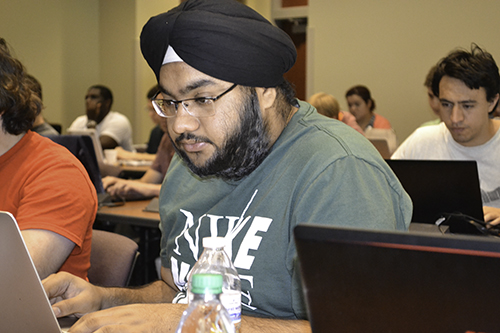
A Petascale Institute participant works with HPC language.
NCSA (the National Center for Supercomputing Applications) is changing the millennial generation and the future of big data with the Petascale Insititute. During the two-week institute, students go from knowing fairly nothing about HPC (High-Performance Computing) language to knowing enough to complete amazing research projects using the Blue Waters supercomputer. From May 22nd to June 3rd, 19 Blue Waters interns (undergraduate students), 10 XSEDE scholars (both undergraduate and graduate students), and four additional undergraduate and graduate students participated in the institute. While Blue Water interns will be working on their research projects from May of this year through May of 2017, XSEDE scholars have a condensed schedule where they’ll be finished with their projects by the end of August 2016.
.jpg)
Several Blue Water interns look on during a presentation.
Regardless of the students’ titles, they are all working on research projects that will greatly utilize Blue Waters or another supercomputer. Their wide range of research topics include synoptic sky telescopes and light curve classification, neuro-network and the cell classification of benign or cancerous cells, star formation, particle simulation for high-energy physics, and metal alloy fusion.
Aaron Weeden, the Blue Waters Student Internship Coordinator at Shodor, explains that they seek to help train “the next generation of competent users of high performance computing and petascale computing” and “to give students the experience that will help them become professionals that can use HPC systems of the future.” They chose to teach about the Blue Waters Supercomputer, a petascale class supercomputer, because “it’s going to give the students an opportunity to see the future of high performance computing and non-high performance computing is going to look like” and it “will let them see the real power of using a system like this to do science.”
Sushma Adari, one of the Blue Waters interns, is an undergrad from the University of Illinois at Urbana-Champaign majoring in computer science and astronomy. When asked about her research, which she is completing with Professor Robert Brunner of the Astronomy department, she says: “There’s a lot of reflux with the synoptic sky telescopes that have a lot of data that’s coming in. My research is going to be automatic classification where I use machine learning to develop models that can basically classify any of the light curves that come in as a result of data collection.”
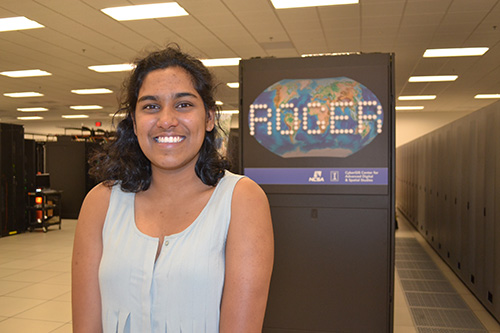
Sushma Adari, an undergraduate student from the University of Illinois, takes part in the Blue Waters Intenship program.
Before attending the institute, Adari was fairly unfamiliar with HPC and thought the experience “was really eye opening, where I was like, ‘Oh my gosh, look, there’s so much information; there’s so much resources that I could use!’” She also enjoyed learning at the institute compared to learning in a classroom because “in the class, you’re always worried about your exams or grades. Coming here, it’s like you’re learning for the sake of learning, and you’re here because you love it, and because it’s your passion. It’s based off your research, so it’s much more fun, and I feel like I get so much more out of it.”
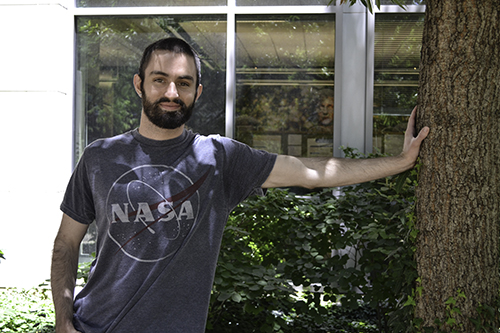
Blue Waters intern Tom Corcoran, an undergraduate at Hood College majoring in computer science and minoring in mathematics.
Another undergraduate Blue Waters intern, Tom Corcoran, attends Hood College in Frederick, Maryland. Corcoran is majoring in computer science and minoring in mathematics. Before the institute, he had no experience with HPC. His assessment of what he’s learned: “It’s really amazing. Just the scale of everything is really blowing my mind and the ability to handle huge amounts of information in a really succinct and timely manner and do problem size I could never even imagine before.”
.jpg)
A Petascale Institute participant examines a model of the Blue Waters supercomputer during a tour of the Petascale Facility.
Corcoran explains that his research problem is “related to training neuro-networks to automatically add color to black and white images, and the goals of this research is to actually take this technique, which already exists, and apply it to automatically detecting whether or not the image of the cell is benign or cancerous.” Using a supercomputer helps Corcoran’s research by creating the ability to scale neuro-networks to really large sizes, which is typically “prohibitive in terms of computation.”
Corcoran has learned a lot from this process and believes the biggest things learned “are probably related to, number one, Linux, and a little bit with system administrated stuff,” as well as learning “about the C programming language” which is sort of the ‘lingua franca’ of computer programming. One of the most useful skills he’s learned is “how to move data around.” If he were unable to move such large data sets, he explains, he “wouldn’t be able to do anything at all.” He is extremely grateful for this opportunity and states, “It’s opened my eyes to all of those resources and what kind of avenues you can take to learn more about this topic and just getting to meet all of these different professionals who are some of the top people in their fields. Doing this type of work is incredibly impressive, and “It’s inspirational.”
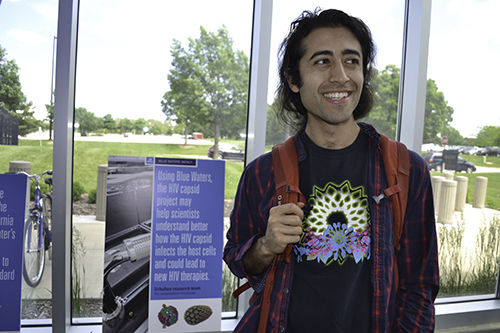
Shervin Sahba, a first year Master’s student from San Francisco State University, during a tour of the Petascale Institute.
Shervin Sahba, a first year Master’s student from San Francisco State University, reiterates what many from the Petascale Institute reported about the benefits HPC. “I’ve been running simulations on a small scale,” he admits, “and there’s only so much you can do. You can create some awesome models; you can test some theories, but there’s a limitation: a limitation of size, a limitation of how sophisticated your models get, and you really compromise that when you do it on a small scale. Large scale, we can get more accurate pictures, many more pictures, test our models, test our theories, so I think it’s very impressive what they have to offer.”
One of Sahba’s big take-aways from this experience was the ability to think in parallel and how to delegate…but to a computer, not a person.
.jpg)
Olivia Irving (right) along with a fellow assistant instructor enjoy a presentation.
“In a funny way, this entire session has been, ‘How do I delegate tasks?’ but not to other people—to a machine—and how do I articulate that? It’s difficult commuting to a group of people and delegating tasks. We’ve all done that scenario at some point. This is doing the exact same thing, but with a network of computers, and how can I partition my tasks in order for them to run parallel and seamlessly come back together. I’ve started to really understand the different protocols and schemes for that.”
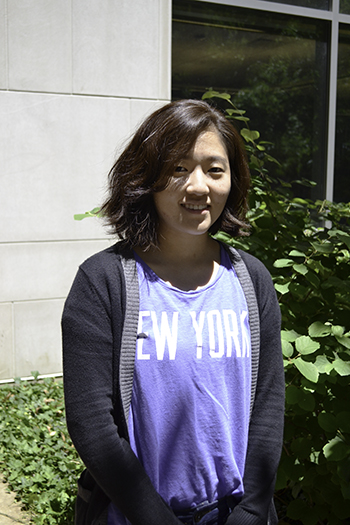
Soojin Lee, an undergraduate Blue Waters intern majoring in mechanical engineering at Georgia Tech,.
One of the XSEDE scholars, Natalie Zimmer, came to the Petascale Institute in order to understand the technical side of HPC. Zimmer, a rising senior at Louisiana State University, is double majoring in physics and astronomy with a minor in nuclear science. The professor she’s conducting research with, Dr. Michael Cherry, was very excited for her to go to the Institute and said, “This is something that’s going to be very useful to our project.” She believes that Dr. Cherry doesn’t “know the details of HPC, but he definitely knows the gist of it and how I can apply it, so it’s good he can guide me.” Her technical skills will compliment his conceptual skills and will greatly enhance their research on “particle simulation for high energy physics,” particularly transition radiation, about which not much is known.
Computer skills aren’t the only skills being acquired at the Petascale Institute. Soojin Lee, another undergraduate Blue Waters intern majoring in mechanical engineering at Georgia Tech, says she personally gained increased motivation.
“I think I was struggling with motivation when I first came here,” she explains. “I think being around people who are very motivated themselves and have some definite goal in mind, I think that helps a lot for me to kind of push through this next year.”
Story by I-STEM undergrad Alexandra Peltier. Photographs by Elizabeth Innes, Communications Specialist, I-STEM Education Initiative.
For more related stories, see: Grad, Undergrad, 2016
For additional I-STEM article about the Petascale Institute, see:
- Petascale Institute Introduces Students to High-Performance Computing
- Interns Have an Up-Close-and-Personal Encounter With Blue Waters
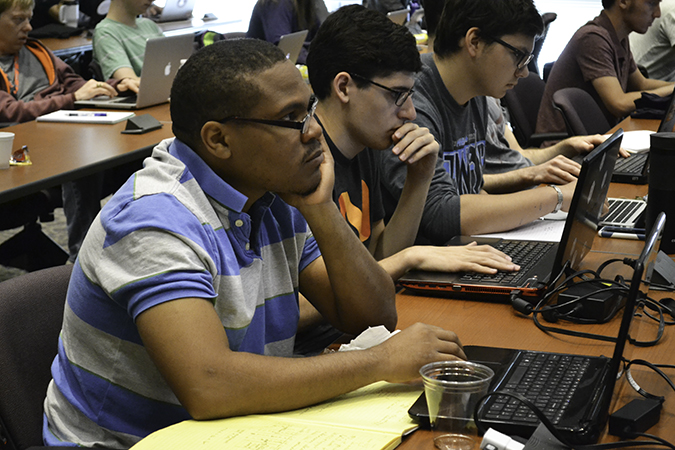
Participants in the 2016 Petascale Institute learn about HPC.













.jpg)
















